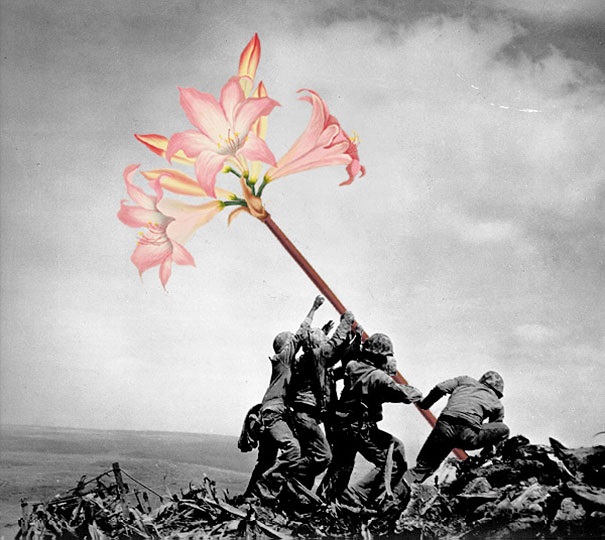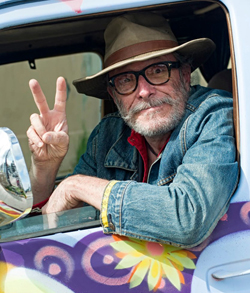by José Luis Mendoza Aubert
This title, at first glance, looks like a clever play on words. On second reflection, we understand that art and revolution are brother concepts. I'd rather say, symbiotic, where one cannot live without the other. But it is too early to reach such a strong conclusion. In this article I intend to present a series of images, somehow chaotic and anarchical, which eventually will form a mosaic that, (I hope) will give us some light and make us think about our artistic labor and our role as social actors in the front row.
Let's start crumbling this delicious semantic and conceptual dish, that, I certainly hope, will unleash controversy, because, when speaking of concepts, one cannot remove oneself from subjectivity and personal appreciation.
The etymological origin of the term "revolution" is very clear; it comes from the Latin. We can be assured that it lies in the Latin word "revolutum" which translates as "spin around" which in my opinion is to not be static, but move, progress, evolve.
Revolution is a radical change or transformation over the immediate past, which can occur simultaneously in different areas. Revolutionary changes have far-reaching consequences and are often perceived as sudden, forceful and violent; it is a breakdown of the established order.
Revolution is a transformation of the set of relations, concepts and/or daily interactions.
After this attempt of a philosophical exercise, more or less easy, over the concept of revolution, we may enter almost fully terra incognita, or what is the same, we will try to clarify this delicately, wild and elusive concept that is art.
Well, here I go.

To me, art is the expression or application of creative human skills and imagination, in very different and diverse ways, producing works to be appreciated primarily for their aesthetic and emotional power. Art allows us to express and cause mostly, ideas, reactions, emotions, perceptions, concepts and feelings, not necessarily positive or beautiful.
Well, so far, more or less easily we have established a basis, however fragile, that will let me continue this philosophical musings.
I want at this moment, as a link, to quote a phrase from one of my heroes of last century, Albert Einstein, who said: "The Revolution introduced me to art, and in turn, art introduced me to the Revolution!" I think this sentence, like many others of our charismatic science icon, speaks for itself.
I want to take this opportunity to share another favorite quote of mine, "Creativity is intrinsic to art, and is inherently a revolution in itself, as it seeks to transcend the established. Therefore art is inseparable from revolution; it is in itself a revolution."
To me, they have always and will always go hand in hand, this controversial "Ménage à trois", "the Revolution, the artist and his work." All have been the reflecting mirror of the social order, all style and form, their failures and successes, its rising or decline, its search, its motion, therefore of its Revolution.
Art is a permitted way to transgress, to judge and, why not, to attack the established order.
Uf! I will leave for a moment this dissertation. Later I'll make a slightly deeper analysis of some of these concepts and ideas.
Taking a quantum leap, we would land in Mexico at the beginning of last century.
The LEAR (not necessarily the famous king of Shakespeare) is a Spanish acronym for the "League of Revolutionary Writers and Artists". Founded in 1933, emulating the "International Union of Revolutionary Writers and Artists" that three years earlier had been founded in Sharkov, in the Soviet Union. The movement had a very short life, as it was dissolved in 1935 during the 7th World Congress of the International Communist.
The aim of the LEAR, was to contribute, through art to unite the working class and to fight against imperialism and war. Unfortunately, this organization had a slow death, as it was slowly losing life, and by the year 1937 was already dead. However, in its short life it was very influential internationally.

This glorious League of Revolutionary Writers and Artists was born in the house of the famous engraver Leopoldo Méndez (1902-1969). The list of its members, not all Communists, is really impressive, Pablo O'Higgins, Silvestre Revueltas, Alfredo Zalce, Julio Bracho, Clara Porcet, Juan de la Cabada, Ermilo Abreu, Luis Arenal, Fernando Gamboa, José Mancisidor, Xavier Guerrero, Santos Balmori and many more.
Some very important characters of the international art scene, frankly Communists, had contact with this movement, including Rafael Alberti, Nicolas Guillen, Pablo Neruda and others.
The LEAR was spread across two legendary publications made by communists, artists and intellectuals: Hoja Popular and Frente a Frente. Undeniably the muralism of that time helped to position Mexico in the vanguard of social revolution through artistic expression. One of the most important representatives was our beloved Diego Rivera.
So much for this first glimpse into this subject. In the following installment, we will take another mouthful of this delicious salad, which will include; Graffiti. Ireland's heartbreaking murals and The Pixaçao in Brazil.
We will also speak about the digestive system of the established order, which eats and assimilates the revolutionary art movements, etc.
For now, I leave you as food for thought a phrase from Subcomandante Marcos from the Zapatista National Liberation Movement in Chiapas, "We are sorry for the inconvenience, but this is a revolution."
**************

José Luis Mendoza Aubert: actor, director and theater technician; teacher and writer of Theater and Plastic Arts; founder and director of the Comedia del Universo theater company and school, operating in San Miguel for the last 20 years; musicologist and cinephile, judge of the En Corto Film Festival now GIFF for 8 years; Director of Art and Culture of the Public Library for 15 years; member of the board of directors of El Sindicato Centro Cultural Comunitario.
José Luis gives talks and workshops on environmental awareness in schools and communities. He is a founding member of the Allende la Cultura Collective. He plays Veracruz music and writes poetry and is a founding member of the music group Jarocha "Soledad".
**************
*****
Please contribute to Lokkal,
SMA's non-profit community publication:
 ***
***
Discover Lokkal:
Watch the two-minute video below.
Then, just below that, scroll down SMA's Community Wall.
Mission

Visit SMA's Social Network
